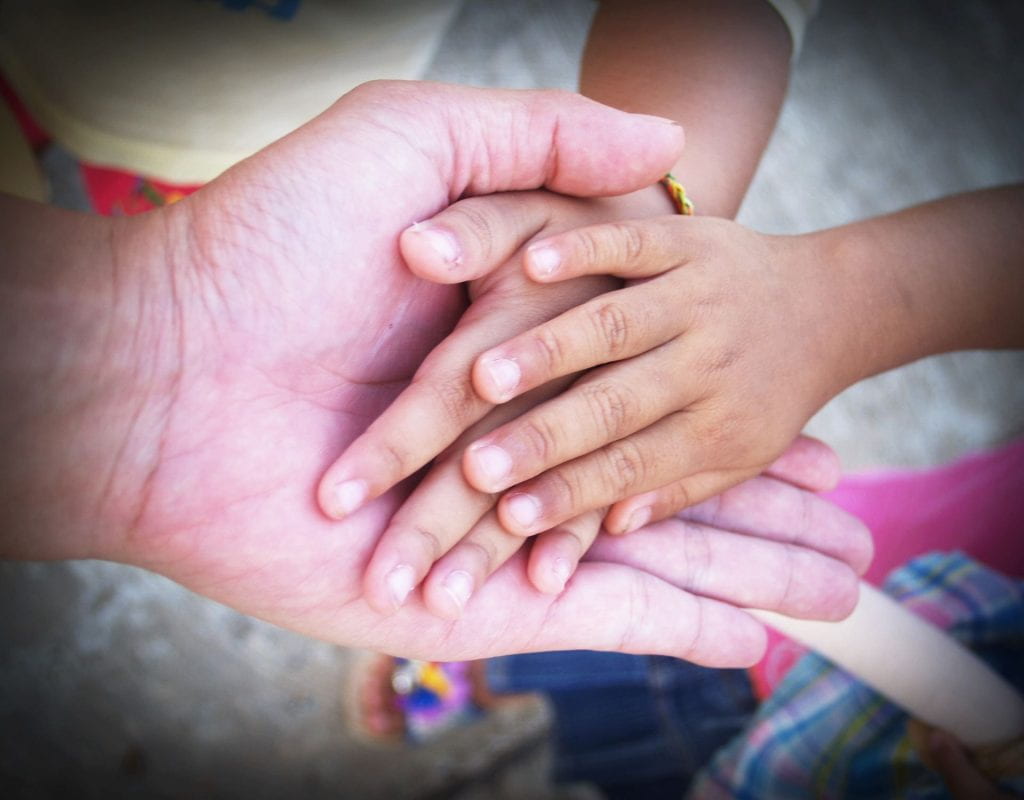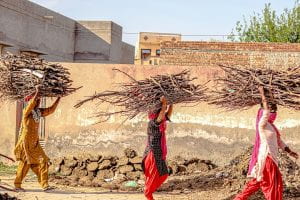
We know that for every action, there is an equal and opposite reaction. And yet, how many times do we (as individuals and as a society) stop and think about what the reaction to some of our actions might be, perhaps on people across the globe?
Women in the global south are largely affected by the destruction of the environment in many ways. For those of us fortunate enough to live in the western developed world, the issues that young girls and women deal with on a daily basis are almost unfathomable. Here are a few ways in which women’s daily lives are affected by the degradation of the world around them.

Water Fetching: The task of fetching water historically falls to young girls and women to manage in the global south. This means walking to fetch water each and every time it is needed. In addition to this being a time-consuming task that pulls young girls from school and women from working to earn wages, the sources of water are changing. Ecofeminism reminds us that when we industrialize the earth around us, there are ecological effects. In addition to water systems being re-routed by mankind for our benefits, the climate change effects of industrialized pollution have caused some water sources to dry up.
Seed Cultivation: We have seen this in the West, and by now, it may be so mainstream, that we don’t even talk about it much anymore. The industrialization of seeds has had detrimental affects on those who farm the land and have a connection to the land. Farmers harvest the seeds from each year to replant the next year. In doing so, these seeds gradually adjust/evolve to the environmental changes that happen around them. What has happened with the manipulation and design of seeds has done away with this ancient and connected practice. Genetically modified seeds have become property of those who develop and produce them. Many companies make farmers destroy their own seed in order to have access to the new seeds which are touted to be resistant to diseases and yield faster and more bountiful crops. Ecofeminist Vandana Shiva has been an advocate for farmers being able to control their own seed production as a way to sustain their livelihood. In addition, she protests the seed monoculture (the planting of just one seed/crop) endorsed by large corporations as well as the increased use of fertilizers and pesticides (The Editors of Encyclopaedia Britannica).

Timber: In India, it’s estimated that 30 million people depend on the forest for their livelihood (Agarwal 129). Through the degradation of the forests to satisfy the demand of consumers worldwide, this had has an impact on women throughout the world. In addition, the statization of forests (control by a few) is leading to both class and gender inequalities (Agarwal 130-137). The lack of access to the forest as well as the destruction of forests from logging has detrimental affects on women in these countries and their earning power.
The commonalities that exist between the western and non-western perspectives of ecofeminism are that they both look at the connection between women and the environment. Both philosophies also commonly accept that there is no one way to look at these issues and there are many threads woven into the tapestry of ecofeminism. An important part of western and non-western ecofeminism is that it takes theory one step further, as it looks at finding and implementing solutions.
As for the western perspective, there is focus on the roles of gender and how women have been oppressed by patriarchal thought and rule since humanity began. The idea of instrumentalism is one where we view the existence of the world for us to take what we need from it. In my previous post, I referenced this quote from ecofeminist Laura Hobgood-Oster, who references how ancient religious systems “proposed that patriarch cultures structure revolved around layers of symbol systems that justified domination” (Ecofeminism: Historic and International Evolution 4). The western lens of ecofeminism looks at how environmentalism and feminism are shaped by the norms of patriarchal society, and how both are damaged by suppression and degradation.
When we look at the non-western perspective, there is focus on how women need their basic safety, hygiene, and wellness needs met. It is virtually impossible for women of the developing world to think about equality amongst men and equal pay for equal work, when issues that western women take for granted are at the forefront of their survival. Young girls and women struggle with access to clean water, which means that safe hygiene practices are at risk when going the bathroom or during menstruation. Ecofeminist Bina Agarwal shares that women are exposed to water borne illnesses more than men due to them collecting and gathering water, washing clothes, and being exposed to pesticide run-off found in water sources (Agarwal 141). In our hierarchy of human needs, the basic ones of survival and safety need to be met first and foremost.
I find the many layers of the global, non-western ecofeminism philosophy interesting. The more I read about the many different facets of the relationship between women, the environment, and the way the industrial world is influencing changes, the more I wanted to know. From the responsibility that women shoulder to fetch water, to the expectation of farming and sourcing food, to caring for those in their families and villages. As we explore solutions to this systemic issue of gender inequality, an ecofeminism lens can help us to look at not only the reality in distribution of domestic duties, but also the expense of what is lost with time, energy, and resources devoted to these life-sustaining responsibilities. Vandana Shiva reminds us about the delicate balance of all things; an increase in production of one thing, will result in scarcity in another (London).
Agarwal, Bina. “The Gender and Environment Debate: Lessons From India.” Feminist Studies, vol. 18, no. 1, JSTOR, 1992, p. 119. https://doi.org/10.2307/3178217.
“Ecofeminism: Historic and International Evolution.” Systemic Alternatives, 18 Jan. 2016, systemicalternatives.org/2016/01/18/ecofeminism-historic-and-international-evolution. Accessed 5 Feb. 2023.
London, Vandana Shiva and Scott. “In The Footsteps of Gandhi: An Interview With Vandana Shiva.” Global Research, 3 Feb. 2016, www.globalresearch.ca/in-the-footsteps-of-gandhi-an-interview-with-vandana-shiva/5505135.
The Editors of Encyclopaedia Britannica. “University of Western Ontario | University, London, Ontario, Canada.” Encyclopedia Britannica, 1 Apr. 2009, www.britannica.com/topic/University-of-Western-Ontario.

Hi Christine,
I enjoyed reading your post this week and it breaks my heart to hear about how these patriarchal societies are so dependent on women. They work so hard to keep everything running smoothly, despite the risk of their health, livelihood, and general safety. All these things really got me thinking if matriarchal societies still exist. The first one that comes to mind is the Amazon society, partly because I’m a nerd and enjoy the Wonder Woman comics. Even in the comics, the reflection of how deeply women are revered and seen as strong beings that can keep a society going, are in perfect health, and aren’t influenced by damaging patriarchal power structures is inspiring.
Based on the research I’ve done, not many of these kinds of cultures still exist in the world today but there are some. These cultures ARE in the western world and they seem to be thriving. It makes me wonder what our world would be like if this way of thinking was adapted in all parts of the world, not just a small few.
Here’s a link that touches on a few matriarchal cultures:
https://www.worldatlas.com/articles/matriarchal-societies-around-the-world.html
Hi Christine,
I enjoyed reading your post, and your comments on water fetching, certainly hit home for me.
Indeed the task of collecting water often falls heavily on women and girls in many Less Developed Countries (LDCs), presenting a significant challenge for their communities. This daily chore not only consumes valuable time, but also poses safety risks, particularly when water sources are located far away or in hazardous areas.
Growing up in Brazil, I know too well the hardship of fetching water. Although our family was lucky to have access to city water, we lived in one of Rio de Janeiro’s oldest neighborhoods in a highland area, where the water supply was limited by low pressure during times of high usage, particularly in the summer. We stored water (still do) in large tanks that ranged from 1,000 to 10,000 liters for daily use. Water pressure and supply problems existed even in the 70s and 80s, leading to occasional shortages.
During times of shortage, when the pressure was low and water did not reach the hilltop, I would walk with my mother to a natural spring at the bottom of our street, approximately a quarter of a mile down from our house, to collect water in 3 to 5-gallon buckets. This task, typically performed by women, was hard physical labor and often performed under the scorching afternoon sun. We would carry the water up the street to our house and up to the “lage” (roof patio) to pour into the holding tank. This process often took the entire day, requiring numerous trips up and down the street, and hours of waiting in line at the spring. We alternated carrying the water until we had enough for our family’s daily hygiene and meal prep needs.
These occasional shortages from the past are now a normal part of life for most low-income individuals and those living in poverty in Rio. The changing nature of water sources, due to industrialization and pollution, is also a major concern for communities, increasing the burden on women and girls and posing serious health risks to those relying on these sources. The city is facing an impending ecological crisis.
If interested, you can read more about the water crisis in Rio de Janeiro below.
https://youtu.be/cfs9L6J2VA8